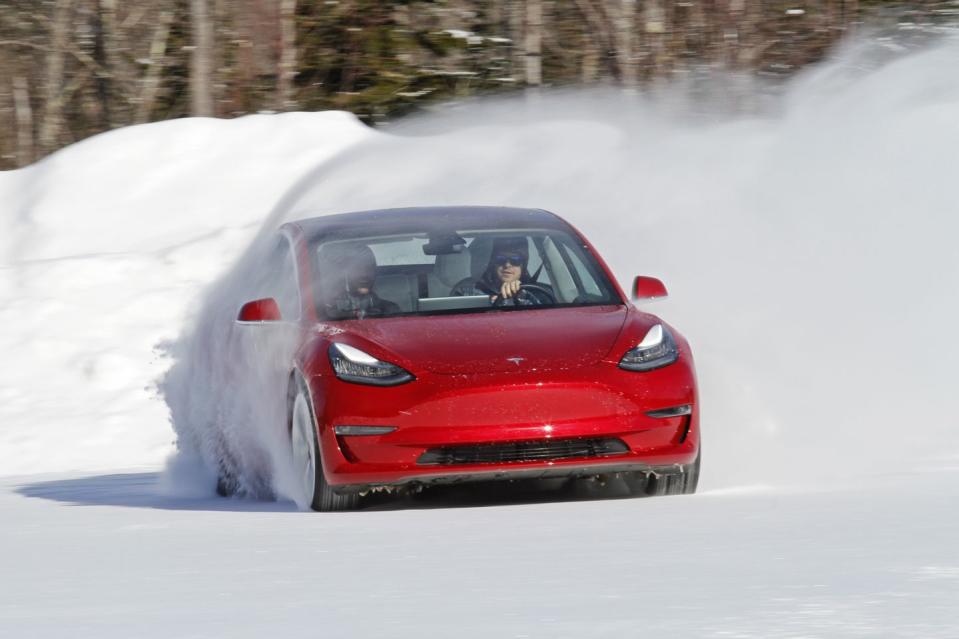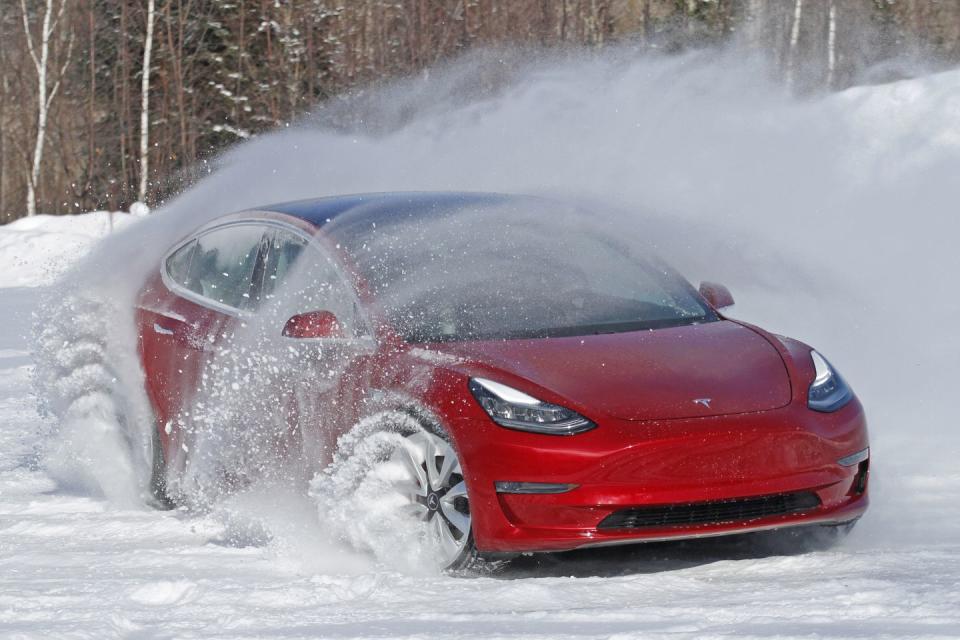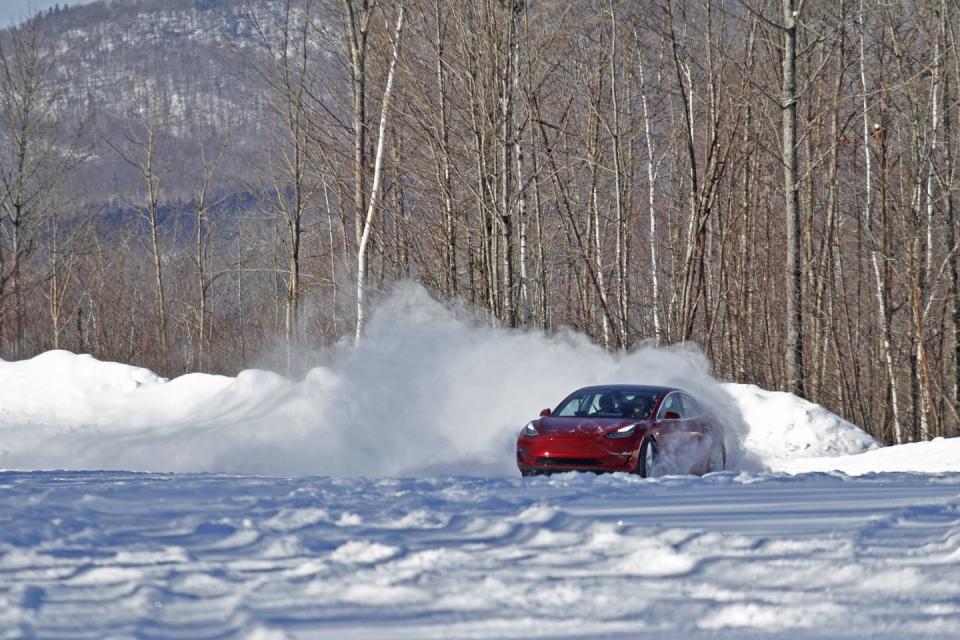Is the Tesla Model 3 a Good Rally Car? We Drifted Through the Snow to Find Out.

“This feels like we’re just flying silently through the forest,” says Wyatt Knox, director of special projects at the O’Neil Rally School in Dalton, New Hampshire. We’re on the unplowed dirt road that leads to the north end of the property, where there’s a huge skidpad and slalom area. Knox is casually driving about 45 mph, using the whole road as four Pirelli Sotto Zero tires dig for traction in the fresh powder.
If you’ve ever watched 30 seconds of a World Rally Championship stage-or a Ken Block video, or an episode of Dukes of Hazzard-then your brain might be adding an aural component to this tableau. A revving engine, shifting gears, maybe the pop-pop-pop of a turbo antilag system. But all we hear is the crunch of snow and the rush of wind, because we’re gliding through the trees in a Tesla Model 3 Performance in Track Mode. The only tracks in the snow ahead of us are from some small woodland creature that trotted along the road, and I wonder if we’ll catch up and surprise the hell out of some fox or raccoon: What? Those big metal things don’t make noise now? Great.
Tesla is known for cheeky nomenclature-most notably, Ludicrous mode-but I get the idea that they were too busy with the Model 3 to expend effort thinking of a catchier name for Track Mode. The premise is that Track Mode readies the car for performance driving heroics, remapping the stability control and thermal management systems for the rigors of racetrack duty. Or, in our case, out-in-the-woods duty.

The straight-line advantages of electric propulsion are well documented, with the quickest versions of the Model S clocking 0 to 60 runs of well under three seconds. The potential for ridiculous agility hasn’t been fully explored, but an electric powertrain unlocks some tantalizing possibilities.
In a rally context, the dual motors should be like having the craziest active center differential ever created. The Model 3 Performance can be front-drive, rear-drive, all-wheel-drive, or anywhere in between. It can change as conditions dictate, within 10 milliseconds. How does that translate on a snow-covered skid pad? Knox and I are about to find out.

We crest the rise to the clearing and Knox backs off the accelerator, turns the wheel to the right and then begins feeding power back in as the rear of the car begins to slide. So far, that’s a lot like what you’d do in any car-induce some lift-throttle oversteer and then catch the slide by finessing throttle and steering. But what happens afterward is way, way, different.
Once the rear end of the car is hanging wide and Knox dials in his line, the car seems to hold a glorious drift without much effort. “This is really good!” Knox says as we scribe a big clockwise circle, powder spraying over the roof sideways like smoke in a wind tunnel. “I can feel it shifting power front to rear to keep this going. Normally you’d be making a lot of little steering and throttle corrections to do these big loops, but this is just locked in.”
We switch seats, and I promptly discover that the Model 3 requires unlearning a few of the rally techniques that Knox himself taught me during previous visits to the O’Neil playground. For instance: In any given gas-powered car, you’re doing a lot of left-foot braking so you can overlap brake and throttle to manage weight transfer, the point being to intentionally upset the car’s balance and induce rotation. In the Tesla, in these conditions, you can drive hard and never touch the brake pedal-in fact, it seems quicker not to. That’s because the dual motors also serve as a rally-ready braking system, providing not only deceleration but asymmetric deceleration from front-to-rear. Release the accelerator while adding steering lock and the car will slow and kick the back end out simultaneously. Add throttle (if we can call it that) and the Model 3 will hold a slide, or straighten the wheel and it’ll bias power to the front to pull you out of it.
“It’s like it’s lightly dragging a rally e-brake to get the back end out when you lift,” Knox says. “And it’s smooth. I think if I were rallying this, I’d just get my hard braking done in the straight line and then use the decel from the motors to get the car turned into the corner.”

I kind of feel like a rally hero, holding big endless 50 mph drifts down into the slalom area, but I also feel like sort of a cheat-it’s like we skipped 10 chapters ahead in the rally-driving instruction manual. Knox doesn’t think that’s a bad thing. “With this car, you can pay attention to weight transfer instead of shifting or thinking about torque curves. It’d be a great car for instructing novices.”
That's a funny thing to say about a car that, on dry pavement, will run 0 to 60 in 3.3 seconds. But it’s true. Knox notes that the Tesla’s smooth decel heading down snowy hills is exactly what you’d want on the street, too. “It must have an inclinometer, because it’s giving us this great engine-braking effect downhill,” he says.

As the morning wears on, we try increasingly silly moves to see if the Model 3 will get serious on us and cut the fun. It doesn’t happen, even when Knox pitches the car into a Ken Block-style reverse-entry turn, where you induce a 180 while going fast enough that the car ends up sliding backwards while all four tires dig in to send you back the other way. We also discover its deep commitment to obeying the command from the helm, even when you do something asinine like go simultaneously full throttle and full lock on the steering. In that situation, which would typically result in grotesque initial understeer, the Tesla somehow pivots around its inside tire and does a tight, not-especially-fast donut with a radius of one Model 3. It’s less like a car than a skid-steer-until you unwind the steering and drift your way out of it. Decide what you want to do, and the Model 3 will do its best to make it happen.

I imagine this car would be a blast on a road course, where Track Mode’s thermal management strategies would come into play. For instance, because the Model 3 Performance essentially has two braking systems-the pads and rotors, and the motors-it can manage heat by biasing toward one or the other as needed. Here in the White Mountains, about an hour from Canada, we have the opposite problem. The temps are in the single digits, so cold that when I take out my iPhone to snap some photos, it bricks within three minutes. I’ve never seen that before. The Tesla, though, is fine. We started with a little less than 200 miles of range remaining (about a 2/3 charge), and after an hour and a half of committed debauchery, we run the range estimate down to about 90 miles. By which point the issue is not the car, but the camera-toting humans who are suffering exposure.

As Knox and I get ready to head back to the O’Neil garage, he speculates about what might be in store for future Model 3s. “Changing a little bit of programming to go into a Ballistic Winter Rally Driving Mode would only be a few tiny tweaks from what it is now,” he says. “But imagine if you had four motors instead of two. Then you’d have instant side-to-side torque vectoring in addition to front-to-rear!” I can imagine. But for now let’s just enjoy the fact that the automotive stability control system, traditional destroyer of fun, has mutated into this: Track Mode, the world’s finest instability control system.
('You Might Also Like',)

